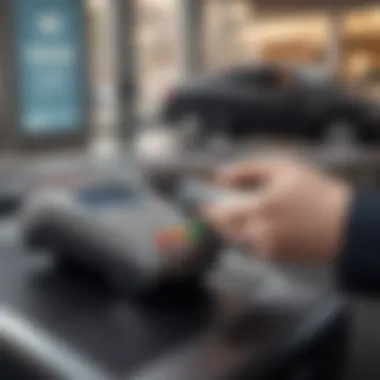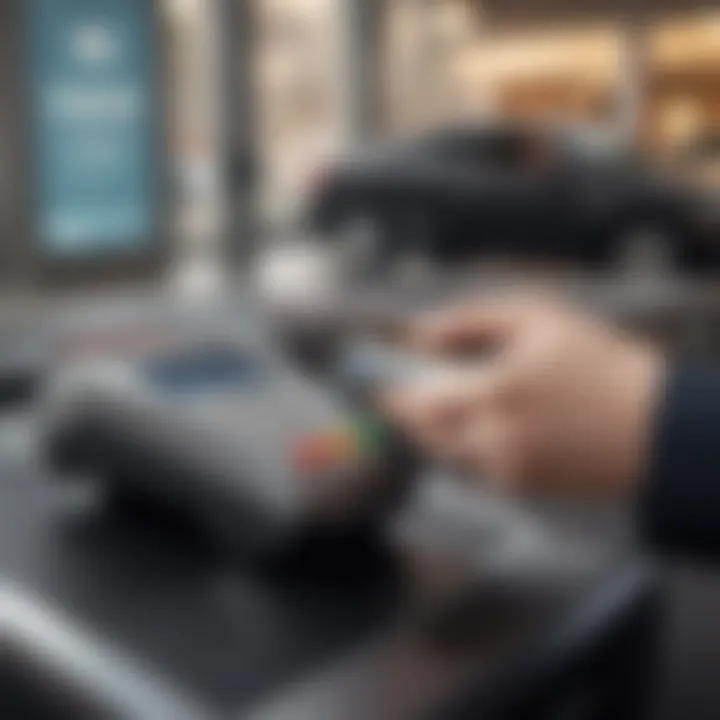Paying a Car Lease with a Credit Card: Benefits & Risks


Intro
Paying a car lease with a credit card can be an attractive option for some individuals. It provides flexibility in payment methods and may offer rewards or benefits associated with credit card use. However, navigating the implications of this choice requires a thorough understanding of both leasing terms and credit card mechanics.
Understanding the factors at play can empower individuals to make informed decisions based on their financial circumstances. Below, we explore essential terminology and concepts to consider when contemplating whether to use a credit card for car lease payments.
Investment Dictionary
Definition of Key Terms
- Car Lease: A car lease is a rental agreement for a vehicle. It typically involves making monthly payments to use the car for a specified duration, usually between two to four years. At the end of the lease, the user may return the vehicle or purchase it at a residual value.
- Credit Card: A credit card allows users to borrow money from a financial institution to make purchases. It includes a credit limit and usually comes with interest fees if the balance is not paid in full each month.
- Cash Advance: This is when you withdraw cash from your credit card, often subject to high fees and interest rates. Using this for lease payments can be costly.
Explanation of Financial Concepts
Understanding financing terms is vital. Here are some relevant concepts:
- APR (Annual Percentage Rate): This indicates the yearly cost of borrowing on a loan or credit card, expressed as a percentage. It's important to know if your card's APR is higher than potential rewards.
- Rewards Programs: Some credit cards offer points or cashback for expenses. Check if your lease payments can be made without extra charges and what rewards may apply.
- Payment Processing Fees: This is a fee that certain merchants charge for accepting credit card payments. Leases might not allowcredit card payments directly, prompting the need for an intermediary payment method.
It is crucial to assess the overall cost of using a credit card relative to its benefits. The decision should not be based solely on immediate rewards.
As we move forward, it is essential to examine the advantages and disadvantages inherent in this payment approach. Readers should bear in mind their financial situation, considering both current needs and long-term goals.
Prolusion
Paying a car lease with a credit card is a topic that deserves careful consideration. This method can offer financial flexibility, but it also introduces unique challenges. Understanding the nuances of this approach is essential for anyone looking to optimize their payment strategy. Not only can it impact your credit score, but it can also affect your overall financial health.
In this article, we will examine how credit cards can be utilized for car lease payments. We will delve into the mechanics of the transaction process, assess the benefits and drawbacks, and outline practical steps for implementation. The objective is to equip readers with valuable insights, helping them make informed decisions based on their financial situations and goals.
Understanding Car Leases
Car leasing is essentially a long-term rental agreement where an individual pays for the use of a vehicle over a set period. Typically lasting between two and four years, leasing offers the advantage of lower monthly payments compared to purchasing a vehicle outright. This can make it an attractive option for those who prefer to drive a new car every few years without the commitment of ownership.
When considering a car lease, it's essential to understand the key components of the agreement. These often include the vehicle's residual value, the money factor, and mileage limits. The residual value determines how much the car will be worth at the end of the lease, while the money factor is analogous to an interest rate. Most leases also come with mileage restrictions, indicating the maximum number of miles you can drive before incurring additional charges.
A critical aspect is the lease payments, which typically comprise the car's depreciation, interest, and taxes. When a lessee makes payments, these funds contribute toward the car's use but do not lead to ownership. Understanding this distinction is vital for anyone contemplating their financial strategy regarding car leases.
Overview of Credit Cards
Credit cards serve as a financial tool that allows users to borrow funds up to a certain limit to pay for goods and services. When a credit card is utilized, the user is expected to repay the borrowed amount, which can include interest if not paid in full by the due date. This mechanism can provide significant advantages, such as convenience, security, and rewards.
Many credit cards come with benefits like cash back, points, or travel rewards. These incentives can be particularly appealing for those who consistently manage their credit card payments responsibly. It's crucial for potential credit card users to understand the terms, including interest rates and fees. Over-reliance on credit cards can lead to debt accumulation, making it essential to evaluate one’s financial discipline.
Furthermore, the ability to pay for a car lease with a credit card could allow lessees to take advantage of these benefits. However, it also raises concerns about interest rates, potential fees, and credit utilization. Understanding the relationship between credit cards and car leases is essential for making informed financial choices.
The Mechanics of Paying a Car Lease with a Credit Card
Understanding the mechanics of paying a car lease with a credit card is crucial. It offers insight into how transactions function in this specific context and sheds light on the potential benefits and possible pitfalls. This section focuses on the technical aspects of the payment process and the different methods available through leasing companies. Knowing these elements is vital for anyone considering this payment option, as they can influence financial decisions significantly.
Transaction Process Explained


When you use a credit card to pay a car lease, the transaction process involves several steps. First, you must ensure that the leasing company accepts credit card payments. Not all companies do, so it is important to check their policy beforehand.
Once you've confirmed that payments via credit card are permissible, the process typically unfolds as follows:
- Initiate Payment: You log onto the leasing company’s payment portal or contact their customer service to provide your payment information.
- Enter Details: You must input your credit card number, expiration date, and security code.
- Confirmation: Upon submitting the information, the leasing company processes the transaction and, in most cases, will send a confirmation of payment.
This whole process usually takes mere minutes. However, one should always verify the charges reflected on the credit statement to ensure accuracy. Moreover, it is essential to account for any transaction fees associated with using a credit card for this payment.
Payment Methods Offered by Lease Companies
Lease companies generally offer a range of payment methods to accommodate their customers. This can include methods such as:
- Online Payments: Many leasing companies provide an online portal where customers can make payments directly using a credit card. This method is usually the most convenient.
- Phone Payments: Some companies allow payments over the phone, a service that can be useful for those who prefer to speak to someone while making the transaction.
- Mail-In Payments: In certain cases, especially for those who do not use credit cards often, lease agreements might allow customers to send payments via check through traditional mail.
It's critical to note that some payment methods may incur additional fees. Credit card payments may carry a convenience fee, which varies widely among different leasing companies. Understanding these fees can help in making more informed decisions about how to pay your lease.
Ultimately, the choice of payment method should be aligned with your financial strategy and comfort level with various payment platforms.
Potential Benefits
Understanding the potential benefits of paying a car lease with a credit card is crucial for individuals contemplating this method of payment. Utilizing a credit card can offer more than just an alternative payment method; it can enhance one’s financial strategy. Each benefit should be assessed carefully to determine its relevance to one's financial goals.
Building Credit History
One significant advantage of making lease payments with a credit card is the opportunity to build credit history. Credit scores are affected by various factors, including payment history. By consistently using a credit card for lease payments and paying it off on time, a person can create a positive payment record. This can lead to an improved credit score over time, which benefits individuals seeking loans, mortgages, or even better credit card offers in the future. However, it is essential to avoid late payments, which can negatively affect this benefit.
Rewards and Cash Back Opportunities
Another aspect worth noting is the rewards and cash back opportunities associated with many credit cards. Some cards offer points or cashback for every dollar spent. Utilizing a credit card to pay for lease payments might help individuals accumulate rewards which can later be redeemed for travel, retail discounts, or even statement credits. For example, if a card offers 2% cash back, making a one-time large payment can result in a significant return. It is prudent to check the credit card terms for specific rewards related to bill payments, as not all transactions may be eligible.
Convenience and Flexibility
Using a credit card to manage lease payments can also provide a level of convenience and flexibility not found with traditional payment methods. Credit cards allow for online payments, which can simplify the payment process, making it more straightforward and efficient. Additionally, many cards allow for automatic payments, helping to ensure that payments are made on time. This reduces the risk of forgetting a due date and incurring late fees. Furthermore, credit cards often come with grace periods, giving cardholders a bit more time to pay off their balance without incurring interest.
In summary, these potential benefits, encompassing credit history building, rewards, and payment convenience, make a compelling case for using a credit card to manage car lease payments. However, it is vital to remain aware of the associated risks and costs. Ultimately, each individual must assess how these benefits align with their unique financial situation.
"Using your credit card wisely can be a strategic move in building your financial future."
By weighing these advantages, individuals can better understand the implications of their payment choices and make informed decisions.
Potential Drawbacks
Understanding the potential drawbacks when paying a car lease using a credit card is essential. Often, this option may appear beneficial at first glance, particularly because of the rewards and convenience. However, the hidden aspects can complicate one’s financial situation. It is prudent to take a closer look at specific elements that may pose obstacles.
Interest Rates and Fees
Interest rates and fees can significantly impact the viability of using a credit card for car lease payments. Most credit cards carry higher interest rates compared to traditional loans. If a balance is not paid in full by the due date, the accruing interest can result in increased costs over time. Lease payments are often structured monthly, meaning consistent charges can pile up, especially if the cardholder fails to manage their financial commitments effectively.
It is also worth noting that some leasing companies may treat credit card payments as cash advances. This characterization can trigger additional fees on top of the standard interest rates. Cash advances often carry higher interest rates, and the grace period for interest-free payments may not apply. The financial implications can quickly escalate beyond initial plans, ?highlighting the need for careful consideration.
Impact on Credit Utilization Ratio


When payments are made with a credit card, it can affect the credit utilization ratio. This ratio is a significant factor in calculating credit scores and is determined by the amount of credit used relative to the total available credit limit. A higher utilization rate can lead to a lower credit score, which may hinder future borrowing opportunities.
As lease payments can be substantial, putting these amounts on a credit card may push utilization into a troublesome range. Ideally, maintaining a ratio below 30% is recommended for those looking to maintain a healthy credit score. If a large lease payment suddenly increases one's utilization substantially, this move may not be as advantageous as perceived.
Lease or Credit Card Limitations
Another aspect to consider is the limitations placed by leasing contracts or credit card agreements. Not all lease agreements allow credit card payments. Some companies explicitly state that payments must come through specific channels, such as direct debit or bank transfers. It is crucial to examine the lease agreement carefully before making such decisions. Lack of clarity may lead to misunderstandings that can affect payment timelines.
On the credit card side, limitations also exist. Most cards have caps on total spending, and this may restrict payment of the entire lease amount, particularly for those with lower credit limits. This restriction can lead to frustration if one intends to use their card for payments to accrue rewards. Understanding these limitations is vital in order to prevent complications in payment schedules.
Considerations Before Utilizing a Credit Card for Lease Payments
When contemplating the payment of a car lease with a credit card, it is essential to examine various factors that can significantly influence your financial situation. The decision to use a credit card for lease payments is not merely a matter of convenience; it also involves understanding the specific terms of your lease agreement, as well as evaluating your personal financial landscape. Both of these elements can have long-reaching effects on your credit and overall financial health.
Reviewing the Lease Agreement
A critical first step is thoroughly reviewing your lease agreement. Many lease agreements have specific clauses regarding payment methods. Some companies may explicitly prohibit payments via credit cards, while others might allow them but with specific conditions or fees. Be sure to clarify the following points in your lease:
- Payment methods: What forms of payment are explicitly accepted? Are there any restrictions?
- Fees: Does the leasing company impose extra charges when payments are made via credit card? A common scenario might involve a transaction fee that could negate the benefits you seek with credit card usage.
- Grace period and late fees: Understand the implications of payment timing. Delays could lead to penalties that impact your credit score.
Revising the lease agreement closely ensures that you comply with all stipulated terms and avoids surprises that may derail planned financial strategies.
Evaluating Personal Financial Situation
Before opting to use a credit card for lease payments, it is vital to evaluate your current financial status. Several core aspects warrant careful consideration:
- Current expenses: Are you able to comfortably manage your regular expenses? Assessing your cash flow will determine if making payments via credit card is feasible.
- Credit card terms: Analyze the interest rates and terms of your credit card. If your card bears a high interest rate, accumulating a balance on it could lead to debt that overwhelms your financial plan.
- Income stability: If your income is irregular, relying on credit cards for significant payment commitments can increase risk.
- Financial goals: Establish your long-term financial objectives. Make sure utilizing a credit card aligns with these goals, whether they involve saving for a home, retirement, or other investments.
Alternatives to Paying with a Credit Card
When it comes to managing car lease payments, using a credit card can be an appealing option. However, there are alternatives worth considering. Evaluating these alternatives can help you decide the best method for your financial situation. Let's examine some of these options that can be more beneficial in certain cases.
Direct Bank Transfers
Direct bank transfers offer a straightforward method for making car lease payments. This option allows you to send funds directly from your bank account to the leasing company, ensuring timely and secure transactions.
Benefits:
- Lower Fees: Many leasing companies do not charge fees for bank transfers, whereas credit card payments may incur transaction fees.
- No Interest Accrual: By using funds directly from your account, you avoid the risk of interest charges that can arise from credit card use.
- Simplicity: Setting up a one-time or recurring bank transfer is typically simple. It's a more traditional method with less complexity compared to credit card transactions.
Considerations:
- Ensure you have sufficient funds in your account to avoid overdraft fees.
- Understand your bank’s processing times to ensure your payment arrives on time.
Use of Third-Party Payment Services
Third-party payment services provide another alternative for you to consider. Services like PayPal or Venmo allow for flexible payment options to your leasing company. However, not all leasing companies accept these methods, so it’s critical to confirm this before use.
Benefits:
- Convenience: You can often send payments quickly using a mobile app, making it easier to track transactions.
- Rewards Potential: Some services offer rewards or cash back on transactions, similar to credit cards.


Considerations:
- Look out for transaction fees that some third-party services may charge.
- Verify that the service is secure and that your information is protected, as not all services offer the same level of security.
Exploring these alternatives can lead to greater financial efficiency and savings in the long run.
By weighing these options against using a credit card, you can make a more educated choice that fits your budget and financial goals.
Steps to Implement Payments via Credit Card
Using a credit card to pay a car lease involves understanding various steps to ensure smooth payments and avoid potential pitfalls. Each step of this process is significant. By following these steps, you can maximize benefits while minimizing risks associated with credit card transactions.
Choosing the Right Credit Card
Selecting the appropriate credit card is crucial. Not all credit cards offer the same terms or rewards. Consider the following elements:
- Interest Rates: Look closely at the annual percentage rates. If you do not pay off the balance completely each month, high interest can accumulate quickly.
- Rewards Programs: Some credit cards provide rewards—cash back or points—for purchases. Select one that aligns with your spending habits to benefit from rewards while paying your lease.
- Fees: Be aware of transaction fees that might be imposed when using your credit card for lease payments. Some lease companies might charge extra fees for credit card payments.
- Credit Limit: Ensure your credit limit can comfortably accommodate your lease payment. Carrying high balances can impact your credit utilization ratio negatively.
Research widely and compare options. Check for any promotional offers that might affect your decision. This diligence can lead to favorable financial outcomes.
Setting Up Automatic Payments
Implementing automatic payments is a practical way to manage your car lease via credit card. Automations lead to consistency in payments and help you avoid late fees. Here are the steps:
- Contact Your Lease Company: Confirm if they allow credit card payments and inquire about their automatic payment setup process.
- Provide Payment Details: Give your credit card information securely and ensure all details are accurate.
- Schedule Payments: Set up a monthly payment schedule that corresponds with your billing cycle. Align this with your income for ease.
- Monitor Transactions: Regularly check your statements to ensure payments are processed accurately.
Automatic payments offer peace of mind and make budgeting simpler, but it is important to stay vigilant to avoid overdraft situations.
Automating your payments can remove the stress of remembering due dates. However, be alert and adjust your settings if your financial situation changes, such as a change in income or expenses.
By focusing on these steps, you can effectively use a credit card for your car lease payments. Careful selection and diligent monitoring can enhance your financial experience.
Maintaining Financial Discipline
Maintaining financial discipline is crucial when considering payments for a car lease through a credit card. The act of integrating credit cards into one's leasing payment routine can offer several advantages, but without proper discipline, these benefits can quickly turn into drawbacks. Understanding how to manage payments effectively is essential to prevent falling into unnecessary debt or financial strain.
Tracking Expenses and Payments
Tracking expenses and payments is one of the foundational steps in maintaining financial discipline. By documenting every payment made towards the car lease, individuals can watch their spending patterns closely. This allows for a clearer understanding of where the money goes each month and helps to identify any areas that require adjustment.
In addition, keeping a record of payments is beneficial when reconciling credit card statements. Discrepancies can arise where a payment is not correctly recorded. Spotting these problems early ensures that billing errors get resolved promptly, preventing unnecessary interest charges.
Regularly reviewing account balances and payment history is also vital. It will be easier to stick to payment schedules and avoid missing due dates, leading to late fees or negative impacts on credit scores.
Establishing a Budget
Establishing a budget is an equally important component of maintaining financial discipline. A well-structured budget allocates funds for car lease payments, insurance, maintenance, and other essential expenses.
When creating a budget, it is necessary to consider income, regular expenses, and savings goals. This process helps determine how much can be comfortably spent on the lease.
A useful approach might involve using the 50/30/20 rule, whereby 50% of income goes to necessities, 30% to wants, and 20% to savings or debt repayment. Following such a guideline can provide a balanced financial outlook, ensuring that lease payments fit within the overall financial picture.
Moreover, keeping track of expenses against the budget allows for adjustments when necessary, ensuring that financial goals remain attainable.
By carefully tracking expenses and establishing a solid budget, individuals can enhance their financial discipline, leading to improved management of lease payments and overall finances.
Closure
Understanding the implications of paying a car lease with a credit card is critical for individuals navigating their financial responsibilities. This practice encapsulates both potential advantages and noteworthy challenges. In this article, we delved into various elements that surround this topic, enabling readers to gain a more informed perspective.
Final Thoughts on Paying a Car Lease with a Credit Card
The decision to utilize a credit card for car lease payments can present several strategic benefits. Primarily, it may contribute positively to one’s credit history, provided payments are made consistently and on time. Additionally, some credit cards offer rewards or cashback, which can effectively lower the overall cost of lease payments.
However, one must consider the interest rates associated with credit cards. If payments are not cleared monthly, accrued interest could negate the benefits of any rewards earned. It’s also significant to assess one's own financial situation, as using a credit card can influence credit utilization ratios, potentially impacting credit scores.
In summary, careful evaluation of the lease agreement and an understanding of personal financial health are crucial before engaging in this payment process. Evaluating alternatives, such as bank transfers or third-party services, may also provide more manageable options. Ultimately, the utilization of a credit card to pay a car lease should align with broader financial goals and strategies, ensuring that it remains a beneficial aspect of one’s financial wellbeing.



